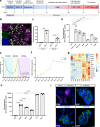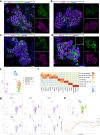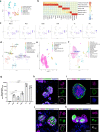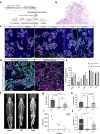Transplantable human thyroid organoids generated from embryonic stem cells to rescue hypothyroidism
- PMID: 36396935
- PMCID: PMC9672394
- DOI: 10.1038/s41467-022-34776-7
Transplantable human thyroid organoids generated from embryonic stem cells to rescue hypothyroidism
Abstract
The thyroid gland captures iodide in order to synthesize hormones that act on almost all tissues and are essential for normal growth and metabolism. Low plasma levels of thyroid hormones lead to hypothyroidism, which is one of the most common disorder in humans and is not always satisfactorily treated by lifelong hormone replacement. Therefore, in addition to the lack of in vitro tractable models to study human thyroid development, differentiation and maturation, functional human thyroid organoids could pave the way to explore new therapeutic approaches. Here we report the generation of transplantable thyroid organoids derived from human embryonic stem cells capable of restoring plasma thyroid hormone in athyreotic mice as a proof of concept for future therapeutic development.
© 2022. The Author(s).
Conflict of interest statement
S.C. and M.R. have filed EU patent regarding the hESC-thyroid derived organoids. All other authors declare no competing interests.
Figures




Similar articles
-
Generation and Differentiation of Adult Tissue-Derived Human Thyroid Organoids.Stem Cell Reports. 2021 Apr 13;16(4):913-925. doi: 10.1016/j.stemcr.2021.02.011. Epub 2021 Mar 11. Stem Cell Reports. 2021. PMID: 33711265 Free PMC article.
-
Thyroid Gland Organoids: Current Models and Insights for Application in Tissue Engineering.Tissue Eng Part A. 2022 Jun;28(11-12):500-510. doi: 10.1089/ten.TEA.2021.0221. Epub 2022 May 20. Tissue Eng Part A. 2022. PMID: 35262402 Review.
-
Generation of functional thyroid from embryonic stem cells.Nature. 2012 Nov 1;491(7422):66-71. doi: 10.1038/nature11525. Epub 2012 Oct 10. Nature. 2012. PMID: 23051751 Free PMC article.
-
Single-Cell Trajectory Inference Guided Enhancement of Thyroid Maturation In Vitro Using TGF-Beta Inhibition.Front Endocrinol (Lausanne). 2021 May 31;12:657195. doi: 10.3389/fendo.2021.657195. eCollection 2021. Front Endocrinol (Lausanne). 2021. PMID: 34135860 Free PMC article.
-
[Advance of researches on thyroid tissues autotransplantation and embryonic stem cell transplantation in therapy of hypothyroidism].Sheng Wu Yi Xue Gong Cheng Xue Za Zhi. 2008 Oct;25(5):1210-2, 1230. Sheng Wu Yi Xue Gong Cheng Xue Za Zhi. 2008. PMID: 19024478 Review. Chinese.
Cited by
-
The highly and perpetually upregulated thyroglobulin gene is a hallmark of functional thyrocytes.Front Cell Dev Biol. 2023 Oct 4;11:1265407. doi: 10.3389/fcell.2023.1265407. eCollection 2023. Front Cell Dev Biol. 2023. PMID: 37860816 Free PMC article.
-
A systematic review on the culture methods and applications of 3D tumoroids for cancer research and personalized medicine.Cell Oncol (Dordr). 2025 Feb;48(1):1-26. doi: 10.1007/s13402-024-00960-8. Epub 2024 May 28. Cell Oncol (Dordr). 2025. PMID: 38806997 Free PMC article.
-
Advances in the Construction and Application of Thyroid Organoids.Physiol Res. 2023 Nov 28;72(5):557-564. doi: 10.33549/physiolres.935102. Physiol Res. 2023. PMID: 38015755 Free PMC article. Review.
-
Progress Toward and Challenges Remaining for Thyroid Tissue Regeneration.Endocrinology. 2023 Aug 28;164(10):bqad136. doi: 10.1210/endocr/bqad136. Endocrinology. 2023. PMID: 37690118 Free PMC article. Review.
-
Derivation of transplantable human thyroid follicular epithelial cells from induced pluripotent stem cells.Stem Cell Reports. 2024 Dec 10;19(12):1690-1705. doi: 10.1016/j.stemcr.2024.10.004. Epub 2024 Nov 7. Stem Cell Reports. 2024. PMID: 39515316 Free PMC article.
References
-
- Kraut, E. & Farahani, P. A systematic review of clinical practice guidelines’ recommendations on levothyroxine therapy alone versus combination therapy (LT4 plus LT3) for hypothyroidism. Clin. Investigative Med.38, E305-E313 (2015). - PubMed
Publication types
MeSH terms
Substances
Grants and funding
LinkOut - more resources
Full Text Sources
Other Literature Sources
Medical
Molecular Biology Databases
Research Materials

